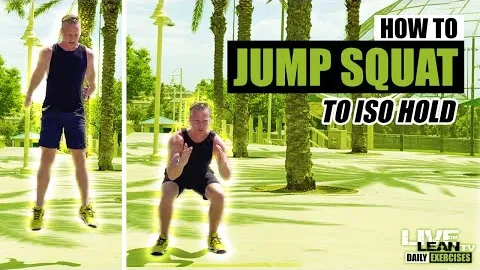

Are you looking to take your lower body workout to the next level? Want to build explosive strength and improve stability? Look no further than the dynamic exercise known as Jump Squat to Isometric Hold. This highly effective compound movement engages multiple muscle groups, elevates heart rate, and helps you burn calories efficiently. In this article, we will explore the benefits, proper technique, and variations of the Jump Squat to Isometric Hold exercise, and how you can incorporate it into your fitness routine for optimal results.
The Jump Squat to Isometric Hold exercise holds numerous benefits for athletes, fitness enthusiasts, and individuals of all fitness levels:
Jump Squat to Isometric Hold is an explosive movement that targets the lower body muscles, including quadriceps, hamstrings, glutes, and calves. The jump squat portion adds a plyometric element, helping to develop explosive power and strength in these muscles.
By incorporating a jump into the exercise, Jump Squat to Isometric Hold directly helps enhance vertical jump performance. The explosive nature of the movement contributes to increasing lower body power, which is crucial for sports like basketball and volleyball.
The isometric hold phase of the exercise significantly challenges your stability and balance. By pausing at the bottom of the squat position, you engage your core and other stabilizing muscles, helping to improve overall balance and coordination.
The Jump Squat to Isometric Hold is a high-intensity exercise that elevates heart rate quickly. This makes it an effective cardiovascular exercise, helping you burn calories, increase stamina, and improve cardiovascular health in a short amount of time.
To perform the Jump Squat to Isometric Hold exercise correctly and safely, follow these steps:
Once you have mastered the basic Jump Squat to Isometric Hold exercise, you can incorporate the following variations to add variety and challenge to your workouts:
This variation involves performing the exercise on one leg at a time. It adds an extra element of balance and stability, as well as challenges each leg individually.
To increase the difficulty, you can hold dumbbells or a kettlebell in each hand during the exercise. The added weight intensifies the workout, further challenging your lower body muscles.
In this variation, start on an elevated surface, like a box or a sturdy bench. Begin by stepping off the platform and immediately performing a regular Jump Squat to Isometric Hold. It helps develop explosive power and strength even further.
To reap the maximum benefits from this exercise, consider incorporating it into your lower body workout routine, 2-3 times a week. Here's an example of how you can structure your workout:
The Jump Squat to Isometric Hold exercise is a challenging and versatile movement that offers a range of benefits for individuals looking to improve explosive power, stability, and lower body strength. By incorporating this exercise into your routine, you can enhance your athletic performance, burn calories, and achieve your fitness goals. Remember to focus on proper form, start with the basics, and gradually progress to more advanced variations for optimal results. So, go ahead and jump your way to a stronger and more stable lower body!
If you're looking for a gym, fitness club or yoga studio, you've come to the right place.
You can find information about gyms in your area. Browse catalog of gyms and find gyms with classes which are you looking for.
On gym page you can find simple information like address, phone or website. You can find list of available classes. You can check availability of personal training or small group classes. On place page you can also see information about open hours.
You can find gyms near you with amenities, courts, studios and equipments.
Use our map to find gym at your city or district.
In Gym Navigator you can find list of exercises with movies for many body parts.
You can browse exercises catalog and find exercises the best of you.
You can also find exercises grouped into workout plans, which you can use to improve you body. Each routine show you exercises one by one and give you possibility to count you progress and count down rest time.